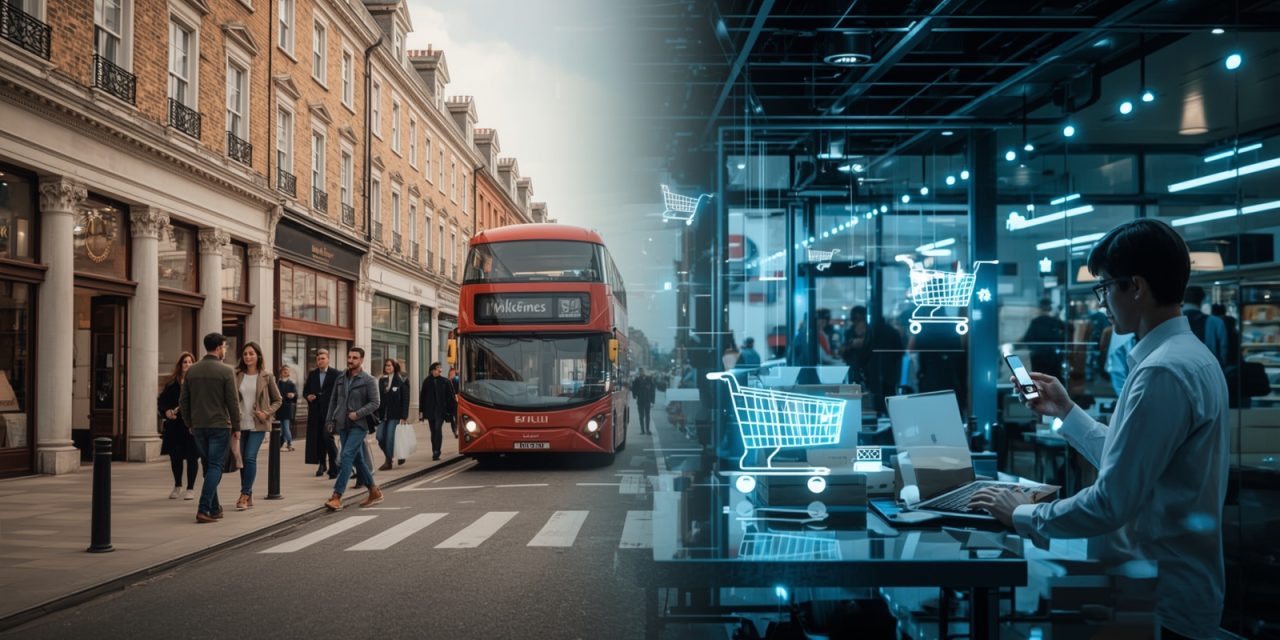Over recent decades, UK consumer behaviour has shifted from traditional high street shopping to convenient digital transactions, influenced by changing lifestyles, technology, and globalisation. This has transformed the UK retail industry and how consumers engage with brands.
Understanding this evolution is essential for business and management students, as it bridges marketing theory with contemporary trends such as e-commerce expansion, retail innovation, and the influence of digital marketing on consumer psychology. This topic provides both academic depth and practical relevance for coursework and professional development.
The Golden Age of the High Street
For most of the 20th century, the high street symbolised the heartbeat of British retail life. Major towns and cities featured bustling shopping zones filled with local stores, department chains, and cafes — where shopping wasn’t merely about buying goods but about experience and community
Consumers preferred in-person shopping because it provided:
- Sensory satisfaction — the ability to see, touch, and test products.
- Human interaction — face-to-face communication built trust and loyalty.
- Immediate gratification — purchases could be taken home instantly.
Brands like Marks & Spencer, Debenhams, and House of Fraser used personalised service and in-store displays to influence buying decisions. Shopping was a cultural and social activity, deeply embedded in UK consumer behaviour.
However, by the late 1990s, cracks began to show. Increasing urbanisation, hectic lifestyles, and the rise of technology started changing what people valued most — convenience and time.
The Digital Revolution Begins
The late 1990s and early 2000s introduced something that completely changed the game: the internet.
With the widespread adoption of broadband, new shopping methods emerged. Amazon UK, launched in 1998, rapidly gained prominence, followed by the entry of eBay, ASOS, and other online retailers. These platforms introduced the ability to shop at any time and from any location.
The initial phase of e-commerce was characterised by experimentation, with many consumers expressing hesitation due to concerns about online payments and data privacy. The introduction of secure payment gateways such as PayPal and HTTPS protocols gradually increased consumer trust.
Between 2006 and 2024, online retail sales in the UK increased from 2.8% to over 30% of total retail transactions (ONS, 2024). This substantial growth reflects a significant evolution in consumer research, evaluation, and purchasing behaviors.
What Drove the Shift? Key Factors Behind Changing Consumer Behavior
A combination of social, technological, and psychological factors contributed to the shift from physical retail environments to digital platforms.
a) Convenience and Time Efficiency
The accelerated pace of contemporary life led consumers to prioritise efficiency and flexibility. Online shopping eliminated the need for travel, queuing, or adherence to store hours. Features such as one-click purchasing and home delivery redefined convenience in retail.
b) Price Competition and Transparency
Instant price comparison tools empowered consumers, with platforms such as Price Runner and Google Shopping enabling the evaluation of multiple offers. This increased competition in pricing strategies and encouraged UK consumers to become more value-oriented, prompting brands to adapt accordingly.
c) Mobile and Social Media Integration
By 2020, over 90% of UK adults owned a smartphone. The proliferation of mobile-optimized websites and shopping applications enabled consumers to browse and purchase products while mobile. Social media platforms such as Instagram and TikTok evolved into digital storefronts, with viral trends rapidly influencing purchasing decisions.
d) Technological Innovation
Innovations in retail technology introduced tools including AI-driven recommendations, chatbots, and augmented reality. These advancements enhanced personalisation and fostered consumer trust through interactive experiences.
e) The COVID-19 Catalyst
The COVID-19 pandemic in 2020 served as a pivotal moment, compelling even traditional consumers to adopt online shopping due to lockdowns. Following the easing of restrictions, many individuals maintained these new behaviours, resulting in a sustained increase in demand for e-commerce solutions.
Retail Innovation: The Rise of Hybrid Shopping Models
Although e-commerce dominates discussions, the UK high street didn’t vanish — it reinvented itself. Retailers began merging the best of both worlds: online convenience with offline experience.
Click-and-Collect Services
Stores like John Lewis, Argos, and Next implemented “click-and-collect” models. Shoppers could order online and pick up in-store — bridging digital and physical retail seamlessly.
Experiential Retail Spaces
Pop-up shops, in-store events, and interactive displays have become part of retail innovation. Instead of focusing purely on transactions, brands now emphasize engagement. Nike’s London flagship, for example, offers digital fitting tools and exclusive member experiences.
Omnichannel Strategy
Retailers integrate data from websites, apps, social media, and stores for a seamless experience. This enables personalised offers and stronger customer relationships.
The Psychology of the Modern UK Consumer
Gaining insight into the psychology of purchasing is essential for understanding the behaviors of contemporary consumers.
Personalization and Identity
Today’s shoppers want brands to understand them individually. AI tools that recommend relevant products create a sense of personal attention, increasing brand loyalty.
Value-Driven Purchases
According to a 2023 Deloitte report, 64% of UK consumers prefer brands that align with their values, especially around sustainability and social responsibility. Ethical shopping has become a defining UK market trend.
Trust and Security
Amid increasing concerns about online fraud, transparency and secure payment systems have become essential. Businesses that establish credibility are more likely to earn long-term consumer trust, which is vital for repeat purchases.
The Power of Digital Marketing
With the intensification of online competition, digital marketing emerged as a primary driver of brand visibility and sales. Companies increasingly utilized data analytics, search engine optimization, and content marketing to attract and retain consumers.
Key tools include:
- Search Engine Optimization (SEO): Improving visibility in Google searches.
- Influencer Marketing: Partnering with social media creators for authentic promotion.
- Email Campaigns: Nurturing customer relationships with updates and offers.
- Content Marketing: Using blogs, videos, and infographics to educate and engage audiences.
These strategies allow retailers to understand consumer behavior in real time and respond accordingly.
The New Era of Data-Driven Retail
The subsequent phase in the transformation of UK consumer behavior is characterized by a focus on data.
In the digital age, every click, search, and purchase leaves a footprint that businesses can analyze to understand preferences and predict behavior. This data-driven revolution has allowed UK retailers to create hyper-personalized experiences and optimize operations at every level.
a) Predictive Analytics and AI
Retailers like Tesco, ASOS, and Ocado use AI algorithms to forecast consumer demand, manage inventory, and personalize recommendations. Predictive analytics helps determine not just what consumers want but when they’re likely to buy it.
For instance, Tesco’s Clubcard data allows the company to offer tailored promotions and targeted discounts based on past purchases. Similarly, ASOS uses browsing data to suggest items that match a customer’s style, enhancing engagement and conversion rates.
b) Customer Relationship Management (CRM) Systems
Customer relationship management (CRM) tools aggregate and centralise consumer data, facilitating the development of stronger brand-customer relationships. Email automation and loyalty programmes enable direct communication, enhancing customer engagement and perceived value.
c) Real-Time Feedback Loops
Digital platforms allow instant customer feedback via reviews, ratings, and surveys. This immediacy helps retailers adapt quickly, improving satisfaction and product quality.
Ethical and transparent use of data allows brands to balance innovation with the cultivation of consumer trust, a critical component of contemporary consumer behaviour.
Sustainability and Ethical Consumerism
Contemporary UK consumers are both digitally engaged and value-driven. They increasingly seek products and services that align with their environmental and social values.
According to the 2024 PwC UK Consumer Insights Survey, 72% of shoppers prefer to purchase from brands demonstrating a commitment to sustainability. This trend toward ethical consumerism is significantly influencing UK market dynamics.
a) Green Retail Innovation
Companies are rethinking packaging, logistics, and supply chains. Brands like The Body Shop and Patagonia have introduced refill stations and recycling programs to minimise waste. Even e-commerce platforms like Amazon UK have adopted carbon-neutral delivery initiatives.
b) Transparent Branding
Consumers increasingly expect transparency regarding sourcing and manufacturing processes. Retailers that disclose information about environmental impact, labour conditions, or charitable partnerships enhance their credibility and foster customer loyalty.
c) Circular Economy Practices
Retailers are experimenting with resale models and clothing rental services. For example, H&M’s “Pre-Loved” initiative encourages sustainable fashion choices, while luxury brands are collaborating with resale platforms like Vestiaire Collective.
The shift toward sustainability represents both a moral imperative and a strategic response to evolving consumer behaviour and the pursuit of long-term profitability.
The Future of Digital Marketing in UK Retail
Digital marketing is evolving in response to technological advancements and increasing competition. Businesses are transitioning from broad campaigns to targeted, data-driven storytelling that engages audiences on both emotional and intellectual levels.
a) Artificial Intelligence and Automation
Artificial intelligence is transforming marketing efficiency. Automated chatbots, predictive content scheduling, and AI-generated recommendations are increasingly standard. These tools enable businesses to deliver personalised marketing at scale while optimising time and resources.
b) Social Commerce
Social media platforms such as Instagram, TikTok, and Pinterest have evolved into integrated marketplaces. Consumers can now purchase products directly through in-app features, eliminating the need to visit external websites. Collaborations with influencers further enhance brand credibility and reach.
c) Voice and Visual Search
With the widespread adoption of smart devices, consumers are increasingly utilising voice assistants such as Alexa and Siri to search for products. Visual search tools enable users to upload images and quickly locate similar products online, thereby enhancing convenience and engagement.
d) Content as a Connection Tool
Educational and interactive content has become essential for fostering brand engagement. Blogs, short-form videos, and tutorials serve both to inform and to position brands as trusted sources of expertise.
These developments provide a valuable foundation for research in business and management studies, particularly in areas such as digital marketing, consumer psychology, and innovation strategy.
The Post-Pandemic Consumer: Hybrid Behaviour
The long-term effects of the pandemic on UK consumer behaviour are still unfolding. Consumers have adopted a hybrid approach that integrates digital convenience with in-person experiences.
a) Click-and-Mortar Shopping
Many consumers now prefer to browse products online and complete purchases in-store. This hybrid model offers a balance between convenience and the assurance provided by physical retail, especially for categories such as fashion, electronics, and beauty.
b) Emotional Value and Experience
Following periods of social isolation during lockdowns, consumers increasingly value experiences that promote connection and enjoyment. Retailers are responding by emphasising community-oriented marketing and personalised service over traditional product promotion.
c) The Rise of Localism
Despite the growth of e-commerce, there has been a resurgence in support for local businesses. Many UK consumers now prefer small, ethical brands that contribute to local economies, integrating online engagement with community values.
The combination of digital innovation and human connection is expected to shape the future of successful retail strategies.
Academic Insights: What Business Students Can Learn
The evolution of UK consumer habits provides valuable academic and professional insights for individuals studying business, management, or marketing.
a) Application of Consumer Behaviour Models
Students can use frameworks such as:
- Engel-Kollat-Blackwell Model (EKB): Explains decision-making stages — from need recognition to post-purchase evaluation.
- Theory of Planned Behaviour (Ajzen, 1991): Useful for analysing attitude-based online shopping decisions.
- Maslow’s Hierarchy of Needs: Helps explain the emotional and psychological motivations behind buying choices.
b) Research Opportunities
Potential topics for dissertations or research projects include the following:
- “The Impact of AI on Retail Marketing in the UK”
- “Sustainability and Consumer Loyalty in E-Commerce”
- “How Influencer Marketing Shapes Gen Z Buying Behaviour”
These topics are closely aligned with academic coursework and are supported by a range of business and management resources.
c) Employability Value
Knowledge of retail innovation and digital marketing equips graduates with skills that are highly sought after in the current job market, including data analytics, search engine optimisation, content creation, and market strategy.
Future Predictions: What Lies Ahead for UK Retail
The future of UK retail will be guided by three interconnected forces — technology, trust, and transparency.
a) Hyper-Personalization
Data and artificial intelligence will enable the delivery of unique experiences to each consumer, ranging from personalised product offerings to dynamic pricing models.
b) Immersive Technologies
Virtual and augmented reality will become mainstream. Imagine “trying on” clothes or visualising furniture through your smartphone before purchasing.
c) Sustainability as Strategy
Sustainable policies will become mandatory, with UK retailers required to report on their environmental impact as part of corporate governance practices.
d) Decentralized Commerce
Blockchain technology has the potential to transform payment systems, customer reviews, and supply chain operations by enhancing authenticity and reducing fraud.
In summary, the future of consumer behaviour in the UK will centre on informed, conscientious, and connected consumers who prioritise both digital convenience and ethical responsibility.
Case Studies: UK Brands Leading the Change
a) ASOS
ASOS revolutionised online fashion retail through data analytics and AI-powered style recommendations. It leverages influencer partnerships and social commerce to connect with Gen Z audiences effectively.
b) John Lewis & Partners
A classic high street retailer that successfully transformed into an omnichannel brand. Their “click-and-collect” model and personalised loyalty programs are benchmarks of retail innovation.
c) Tesco
Tesco utilizes Clubcard data analytics to personalise offers for millions of customers, exemplifying how digital marketing and data-driven strategies can foster long-term customer loyalty.
These examples illustrate how UK retailers are integrating traditional practices with technological advancements to address evolving consumer expectations, providing valuable insights for management students and entrepreneurs.
Understanding the Modern Customer: From Market Research to Effective Marketing
In today’s competitive UK retail landscape, success begins with truly understanding customer behavior, which is crucial for business growth and sustainability. Modern customers buy not only based on product quality or price but also on emotional connection, convenience, and brand values. For businesses, identifying the target audience is the first step in crafting personalised strategies that resonate with what consumers choose and why they choose it. This process involves conducting market research — analysing data, trends, and feedback to study consumer needs, expectations, and motivations.
When brands understand consumer behavior, they can predict purchasing decisions and design campaigns that speak directly to their target market. Recognising what customers expect — such as fast delivery, ethical practices, and seamless service — is crucial for business leaders aiming to deliver an exceptional customer experience. Moreover, social proof, including reviews, testimonials, and influencer collaborations, has become a powerful driver of trust and credibility in purchasing decisions.
Ultimately, effective marketing today means building meaningful relationships rather than focusing solely on transactions. Brands that continually analyse data, adapt to shifting preferences, and align with customer values can stay ahead of competitors. In an age where customers expect transparency and engagement, understanding behavioural patterns and motivations is not just helpful — it’s crucial for business success in both digital and traditional markets.
Conclusion
The transition from high street retail to e-commerce signifies more than a change in shopping channels; it reflects broader shifts in lifestyles, technological advancement, and social values. Modern UK consumers are informed, connected, and conscientious, expecting brands to provide value that extends beyond the product.
For students, researchers, and professionals, comprehending this shift is essential. It involves not only analysing trends but also predicting consumer behaviour, adapting strategies, and leading within a dynamic digital economy.
As the UK continues to integrate retail innovation, digital marketing, and ethical business practices, it is evident that future success will favour brands and professionals who recognise that understanding consumer behaviour requires both analytical and creative approaches.
Frequently Asked Questions (FAQs)
Q1: What are the key factors influencing consumer behaviour in the UK today?
Key influences include convenience, price transparency, sustainability, social media, and technological innovation. Consumers expect seamless online experiences and ethical business practices.
Q2: How has e-commerce changed the retail industry in the UK?
E-commerce has redefined accessibility and competition. Retailers now reach global audiences, operate 24/7, and use real-time analytics to predict trends.
Q3: Why is sustainability becoming essential for UK retailers?
Modern consumers want eco-friendly and ethically sourced products. Sustainable operations not only attract conscious buyers but also improve brand reputation and long-term profitability.
Q4: What digital marketing strategies are most effective today?
SEO, influencer marketing, personalised email campaigns, and content marketing are dominant. Brands using AI-driven personalisation achieve higher engagement and conversions.
Q5: What can students learn from the evolution of UK consumer behaviour?
Students gain insights into market adaptation, technology’s impact on business models, and how retail innovation shapes strategy. This knowledge is invaluable for coursework, dissertations, and practical projects.
Q6: How can Business Management Assignment Help assist students in this topic?
These services offer research guidance, data interpretation, and topic frameworks. They help students structure essays and reports effectively while maintaining academic integrity.
Q7: What’s the biggest trend shaping the future of UK retail?
The biggest trend is hyper-personalisation — combining AI, sustainability, and digital integration to deliver unique, ethical, and data-driven shopping experiences.





